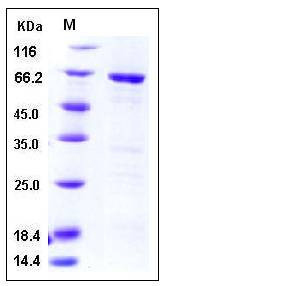Human MAPKAPK3 Protein (GST Tag)
3PK,MAPKAP-K3,MAPKAP3,MAPKAPK-3,MK-3
- 100ug (NPP4071) Please inquiry
| Catalog Number | P10683-H09B |
|---|---|
| Organism Species | Human |
| Host | Baculovirus-Insect Cells |
| Synonyms | 3PK,MAPKAP-K3,MAPKAP3,MAPKAPK-3,MK-3 |
| Molecular Weight | The recombinant human MAPKAPK3/GST chimera consists of 607 amino acids and predicts a molecular mass of 69 kDa which is also estimated by SDS-PAGE. |
| predicted N | Met |
| SDS-PAGE |  |
| Purity | > 90 % as determined by SDS-PAGE |
| Protein Construction | A DNA sequence encoding the full length of human MAPKAPK3 (NP_004626.1) (Met 1-Gln 382) was expressed with the GST tag at the N-terminus. |
| Bio-activity | Kinase activity untested |
| Research Area | Cancer |Signal transduction |Signaling Pathway |Representative pathway |MAPK singaling Pathway |
| Formulation | Supplied as sterile 50mM Tris, 100mM NaCl, pH 7.5, 0.25mM DTT, 0.1mM EDTA, 0.5mM PMSF, 10% glycerol 1. Normally 5 % - 8 % trehalose, mannitol and 0.01% Tween80 are added as protectants before lyophilization. Specific concentrations are included in the hardcopy of COA. |
| Background | The MAPKAP kinases are a group of MAP kinase substrates which are themselves kinases. In response to activation, the MAP kinases phosphorylate downstream components on a consensus Pro-X-Ser/Thr-Pro motif. Several kinases that contain this motif have been identifed and serve as substrates for the ERK and p38 MAP kinases. Mitogen-activated protein (MAP) kinase-activated protein kinase 3, also known as MAPKAPK-3 and 3pK, is a member of the Ser/Thr protein kinase family. It is Widely expressed in human tissues, with a higher expression level observed in heart and skeletal muscle. No expression in brain. MAPKAPK-3 is unique since it was shown to be activated by three members of the MAPK family, namely extracellular-signal-regulated kinase (ERK), p38, and Jun-N-terminal kinase (JNK). It is highly activated both by mitogens and by stress-inducing agents or proinflammatory cytokines, and translocates to the cytoplasm from nucleus. MAPKAPK-3 is exclusively activated via the classical MAPK cascade, while stress-induced activation of MAPKAPK-3 is mainly mediated by p38, however the mechanism defining the specificity remains unknown. |
| Reference |
